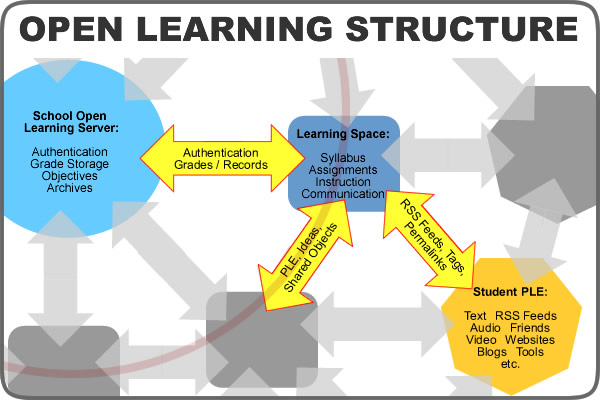So in part 1 of taking a bird’s eye view of open learning structure, I focused mainly on the authentication issues surrounding privacy as well as the basic flow of information in an open learning structure. I wasn’t intending to do a series, but a few good questions and comments made me realize that I needed to expand on the parts that I didn’t focus on and look at some of the basics of how they would also work. It also became evident that I needed to expand the diagram a bit. So, with that, I want to look a bit at the Instructor Space which – based on Alan Levine (@cogdog) excellent comment – has been renamed:
Learning Space
The basic idea is that the learning space could be anything that the instructor or learner thinks works best for the class. It can be set-up ahead of time by a teacher or group of teachers, or mutually agreed upon by the learners and/or teachers. It could be a Learning Management System, a blog, a Facebook page, or a combination of many things. This differs from the standard institutional approach where one tool (usually an LMS) is adopted for everybody and then individual instructors and learners have to figure out how to adapt their learning to fit in that mold.
This touches on a key idea for an open learning concept of a learning space – the learning space is more of an aggregation point, not THE place that all learning “happens.” The learning space would aggregate content from many spaces and then export that content so that learners would still interact with the course through their own personal learning environment. The instructor also interacts with the class through the learning space of their choice. No one has to really learn to use a new system or force things to work in a giant LMS because they are using the tools that they have been using all along. Or, optionally, they can choose to change to something they think will work better.
Or, at least, that is the idea. As Jim Groom pointed out on Twitter, the technology is not quite there yet.
Once it is, I think there will really be two parts to the Learning Space. One is the instructor’s own Personal Learning Network, where they can pull in ideas from other experts, articles, current events, and all kinds of other content. As George Siemens has pointed out, instructors need to avoid teaching alone – so pulling in others in very important. The other part of the Learning Space would be the aggregation and distribution tools that export this content out to the learners, as well as importing student work for review and distribution.
Another aspect of the aggregation part of a Learning Space is the technical aspect of authentication. In some arenas this exists – in others, not so much. Technology already lets an instructor open up their course to let anyone join in. Blogs, RSS readers, and even LMS applications let guests in. But there is also going to be the case where students need to be authenticated with official records to allow for credit, grades, etc. Technological architecture and standards need to be developed that allow students to go to any random learning space and log in with official school credentials. This login would be securely authenticated with school servers. Students then have an account on the learning space where they control their identity. They can connect their blog, Twitter feed, or whatever to that account. The student, say Freddie Smith, would then choose to use his real name or a complete alias. Only the instructor and the software running on secure connections would know that the “AllKnowingOne’s Blog” is also Freddie Smith. Freddie could also change his privacy per course he is taking – if one course seems a bit too personal he can stay anonymous where as in another course about basic concepts he can use his real name. The control would be on a per class basis, totally up to the learner.
Another important reason that this authentication piece is important is that to “remain in ‘compliance with federal distance education regulations’ you have to login through a centralized, campus-wide authentication system” as Jim Groom recently blogged about. There are ways to do this with different systems, but not so much with others. Once the technology advances a little, hopefully we will see a streamlined set of standards that can be plugged into any system from WordPress to Google to whatever else comes down the road.
So, adding the next piece of the puzzle to the Open Learning Structure diagram, we come up with this:
This shows the added element of instructors interacting with their own PLE to add to the Learning Space. In Part 3, I want to look more at the Student PLE piece of the diagram by adding another arrow representing a different flow of information.
Matt is currently an Instructional Designer II at Orbis Education and a Part-Time Instructor at the University of Texas Rio Grande Valley. Previously he worked as a Learning Innovation Researcher with the UT Arlington LINK Research Lab. His work focuses on learning theory, Heutagogy, and learner agency. Matt holds a Ph.D. in Learning Technologies from the University of North Texas, a Master of Education in Educational Technology from UT Brownsville, and a Bachelors of Science in Education from Baylor University. His research interests include instructional design, learning pathways, sociocultural theory, heutagogy, virtual reality, and open networked learning. He has a background in instructional design and teaching at both the secondary and university levels and has been an active blogger and conference presenter. He also enjoys networking and collaborative efforts involving faculty, students, administration, and anyone involved in the education process.

One thought on “Open Learning Structure Part 2”